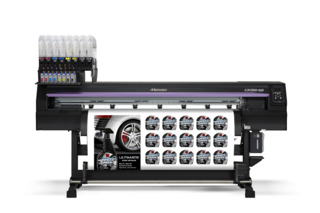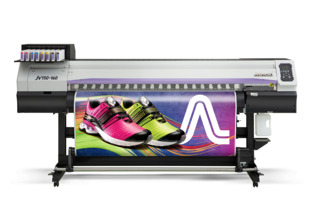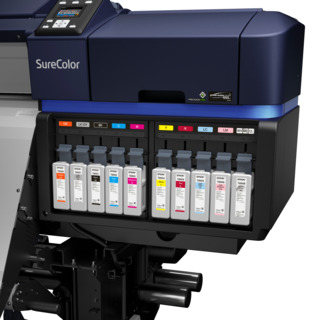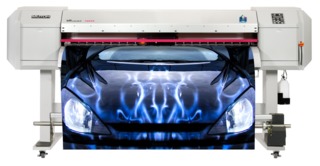Eco-Solvents: A Vibrant Alternative
Solvents and eco-solvents have continued to be a player in wide-format production.

Printed books. Movie theaters. Brick-and-mortar stores. Just three things that the “experts” indicated would almost immediately disappear once another technology came along that provided the user with an alternative method of delivering the product (the internet, video tapes/DVDs, and online retailers, respectively). But while it’s true that the disruptive alternatives have had their impact, their forerunners are still very much a part of our lives.
Similarly, our market has seen new technologies come along in recent years that many predicted would result in the complete elimination of solvents. And, indeed, year-to-year growth in demand for solvent and eco-solvent based digital printers and inks may not be as dramatic as in years past. But they will likely remain a print technology that many shops bring into play when producing wide-format graphics and signage in the U.S. for the foreseeable future.
“Robust solvent is going away and has been for years, whereas eco-solvent continues to grow, albeit at a modest rate,” says Tim Greene, research director, Hardcopy Solutions, International Data Corporation (IDC). He estimates growth in demand for eco-solvent inks will be somewhere in the neighborhood of five percent this year.
Looking ahead, Susie Mendelssohn, international marketing manager for INX Digital, says she expects solvent and eco-solvent inks to retain their “appeal for the most price-driven markets, although as more entry-level UV-curable printers come into the market globally, we will probably see a downtown in solvent technology. The one area we can see an advantage with solvent-based products is in cost for manufacturers, which allows these companies to be competitive in price-sensitive markets.”
Lily Hunter, product manager, textiles and consumables, for Roland DGA, expects eco-solvent printers and inks will retain their appeal, even as alternatives become more prevalent.
“I don’t think the availability of other types of inks, such as UV or dye-sublimation, pose a threat to importance or popularity of eco-solvent inks,” she says. “PSPs are simply adding these other inks and technologies to their existing workflow in order to diversify and expand their product offerings. They are not ‘replacing’ eco-solvent inks in any way.”
Eco-solvent advantages still resonate
For many print service providers (PSPs), cost can be a guiding factor in what system they buy, when they upgrade, and whether they migrate to newer print systems.
“Demand for eco-solvent printing has remained strong, even as new ink technologies have been introduced to the market,” says Dave Conrad, director of sales and marketing, Mutoh America. ”Price competitiveness and the ability to perform better for more applications using a wider selection of competitive media are the key advantages eco-solvent printers have in the market today.”
Michael Maxwell, senior manager, sign graphics business development and marketing, Mimaki USA, agrees: “Eco-solvent and solvent inks still present the most versatile opportunities for general graphics intended for indoor or outdoor use,” he says. “We estimate that more than half of all wide-format users still utilize solvent printer and ink technology.”
Continued advances in ink have helped create new ways to use those systems. The overall trend, says Greene, has been to boost eco-solvent inks’ endurance and color gamut while reducing or eliminating odors. “Manufacturers of these inks and printers have done a good job improving the image quality to make eco-solvent inkjet prints more applicable to indoor graphics, as well,” he notes.
Colors, quality expanded applications
Eco-solvents can also now tackle a much broader range of applications than their robust brethren, enabling shops to grow their business.
At Epson America, professional imaging product manager Matt McCausland credits the superior image quality attainable with the latest eco-solvent printers as a practical advantage for wide-format used in any setting. “In regards to image quality, the printhead technology utilized by most eco-solvent wide-format printers is capable of creating near-photographic quality prints,” he points out. “As PSPs look to provide added value, they often look to improving the image quality they offer their customers.”
As an example, McCausland suggests owners of an Epson SureColor S series printer, with its Epson Precision Core TFP printhead, can expand beyond traditional services to produce fine-art and photo reproductions, stickers, and backlit film. It’s the combination of advances in solvent print technology and the expanded catalog of eco-solvent inks that’s allowing those opportunities. Epson’s Ultrachrome GS3 inkjet, McCausland notes, includes a dedicated red ink for an expanded color gamut. “PSPs can now confidently hit up to 98.2 percent Pantone overage on the SureColor S80600 and accurately match those difficult to hit red brand colors,” he says.
Newer ink colors Mimaki developed for its eco-solvent printers – like orange and light black – says Maxwell, allow owners of its solvent and eco-solvent printers to produce the photo-quality prints that were formerly outsourced to a photo lab or specialist print provider. “Mimaki’s white and metallic silver solvent offerings, combine with our versatile cutting capabilities have also created a demand for POP (point of purchase) and POS (point of sale) applications that may have been serviced by traditional printing methods,” he adds.
At Mutoh, Conrad cites the wider color gamut and durability of Mutoh’s Ultra Inks as contributing factors to the enduring appeal of appeal of Mutoh’s ValueJet line of eco-solvent printers. “With the wider color gamut, Mutoh EcoUltra inks open the door to more photo realistic type applications for specialty and commercial printers,” he explains. “And the durability achieved with Eco-Ultra inks makes them a better choice for outdoor applications and high traffic areas where environmental wear is a factor.”
Hunter attributes the popularity of Roland’s eco-solvent inks and printers to their versatility, vibrancy, durability, and quick-drying qualities. “Our Eco-Sol MAX, Eco-Sol MAX 2 and new TrueVIS Ink formulations image beautifully and can be printed on a wide variety of media, including paper, vinyl, coated fabrics, polyester films, and more,” she says. “These high-quality GreenGuard Gold-certified inks also lend themselves well for ‘green’ applications, especially when used in combination with environmentally friendly media like Roland’s Wallflair Removable Fabric.”
Buying into versatility
When choosing between ink types to bring into their shop (or retain/replace), print providers have a host of factors to take into account.
Conrad advises assessing intended applications – and the best printer and ink system to produce that output. “Is color gamut important? Is media variety important? Will they be limited to OEM media if they choose a certain ink type? What about physical requirements like power to support the printer and extra heaters if necessary?” he asks. “Ink selection can affect all of these.”
PSPs should compare print samples from several eco-solvent printers to identify what speed and pass mode matches the shop’s production needs, McCausland recommends: “Six passes on one machine may be equivalent to quality to 8 passes on another machine,” he notes. “Total cost of ownership is also crucial. Have your reseller do comparisons on multiple models to get an idea of the true TCO – don’t simply judge by the manufacturer’s suggested retail price on ink and media.”
With many PSPs now in their third- or fourth-generation solvent or eco-solvent print system, Maxwell says the decision whether to upgrade or replace comes down to evaluating a wide-format printer’s features and ink performance. “Specially matched printers and ink systems with features that provide quality, reliability, and overall value are most important,” he advises. “Look at a manufacturer’s entire product offering. Having access to a manufacturer who understands other technologies will make it easier to understand the best solution for your needs.”
If budget is a driving factor, an eco-solvent printer may be one of the logical choices at this point in time. “There is the perception that this is a mature technology, so some vendors are offering excellent deals on eco-solvent equipment right now,” advises Greene.
Hunter expects eco-solvent printer and inks will retain their appeal with those looking for the most ways to expand their business: “Print service providers should ask themselves whether they want to create additional revenue streams by being able to handle a wide variety of applications in house, or whether it makes sense to outsource some jobs. I’ve found many people are unaware of the incredible versatility of eco-solvent printers and inks and all the different types of output they can produce. Eco-solvent goes way beyond simple banners and posters.”






